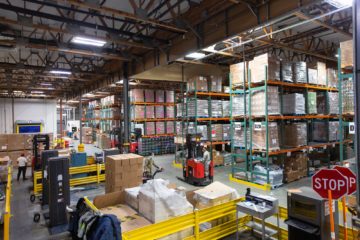Gabby Meerwarth, Volunteer Manager
In the IPCC’s (Intergovernmental Panel on Climate Change) “Special Report on Climate Change and Land” released in 2019, food waste reduction is characterized as one of the most effective ways to mitigate and adapt to climate change. In California alone, food waste makes up about 18 percent of material that goes to landfills. That food is composed of a lot of wasted resources and emissions.
Combating food insecurity and reducing food waste go hand in hand, and non-profit grassroots organizations play a big role in these parallel fights. Each Green Corner is proud to be among the organizations making a difference, and we do so by partnering with local food banks like Second Harvest of Silicon Valley. Just this week, one of EGC’s Residential Garden Stewards gave a large donation of oranges and lemons to Second Harvest. By donating that fruit, the Steward prevented it from being wasted on the ground, and provided some fresh produce to those who are food insecure.
EGC asked Second Harvest a few questions to find out more about how they prevent food waste in their operation. Read the Q&A below for some insight into the inner workings of a foodbank!
How do you store the food that is donated to you? What are the logistics of the operation?
The food comes into our warehouses and is then sorted into smaller boxes by volunteers, staff, members of the National Guard and the San Jose Conservation Corps. The pre-packed boxes of food are then transported to our distribution sites located throughout Santa Clara and San Mateo counties. Since the pandemic, we now have 130 drive-through distribution sites where those boxes are loaded directly into the trunks of our clients cars by volunteers.
How much of the food donated to Second Harvest is perishable?
About 74% of Second Harvest’s food is donated and the majority of that is fresh produce. Even at the elevated level of need (We went from serving 250K people a month pre-pandemic to 500K people a month since the pandemic hit) we are still focused on nutrition: we have aimed to keep our mix of groceries as close to 50% produce and 25% protein/dairy as possible throughout our emergency response.
How do you ensure that produce stays fresh?
We have warehouses equipped with energy efficient refrigeration to store fresh produce, eggs, fresh milk, juice, and other donated dairy items. Our freezers store meat such as frozen turkeys or poultry, particularly during the holiday season when we have turkeys, hams, and so forth. Our distribution model is very efficient, so in general, produce and perishable food is not stored at the warehouse for long before it is transported to a distribution site out in the community. We have to move quickly!
Has Covid-19 impacted Second Harvest’s ability to prevent food waste? If yes, how so? How has Second Harvest adapted to these challenges?
In the beginning of the crises many food purveyors were left with excess inventory, as their stores and warehouses closed temporarily and they needed to move the products. Second Harvest took on many of these donations as donors were in some cases able to provide transportation. Our transportation team was hard pressed to pick up many of these donations so negotiating deliveries made this process a bit easier. We have experienced transportation and storage issues. Working closely with our agency partners has made this a better process and has gotten many desirable products to our agencies and the community. We have gained many new contacts with manufacturers, retailers and distributors and have sourced items we didn’t ‘t ask for in the past such as masks and hand sanitizer.
How would you describe the impact of food banks on the issue of food waste?
Food waste has been on Second Harvest’s radar for many years. Many food banks have worked with local retailers, manufactures, growers and distributors to source their product that for many reasons can’t or won’t be sold. A bill that was passed in the California Senate in 2018, SB1383 requires that retailers and manufacturers reduce their waste of edible food that can be donated, by January 1, 2022. Over the past couple of years, Second Harvest has been working with many of these entities to start, enhance, or improve their donation programs. [Many retailers are reaching out and our agencies are picking up these donations and distributing it, so that food doesn’t even need to come back to our warehouse.]
We at EGC would like to thank Second Harvest of Silicon Valley for all that they do. Preventing food waste and food insecurity are missions that require a lot of dedicated volunteers and a lot of organization. During this pandemic, such work has become more difficult but also more important than ever.
Sources:
Mbow, C., C. Rosenzweig, L.G. Barioni, T.G. Benton, M. Herrero, M. Krishnapillai, E. Liwenga, P. Pradhan, M.G. Rivera-Ferre, T. Sapkota, F.N. Tubiello, Y. Xu. (2019). Food Security. In: Climate Change and Land: an IPCC special report on climate change, desertification, land degradation, sustainable land management, food security, and greenhouse gas fluxes in terrestrial ecosystems. IPCC. https://www.ipcc.ch/srccl/chapter/chapter-5/
California Department of Resources Recycling and Recovery (2018). Preventing Food from Reaching the Landfill. CalRecycle.ca.gov. https://www.calrecycle.ca.gov/organics/food/



0 Comments